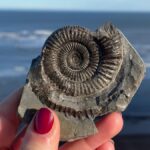Whitby and its surrounding areas are home to some of the best beachcombing spots in the UK.
From fossils dating back to the Jurassic and Cretaceous periods to exquisite pieces of amber and jet. You never know what you might discover along the shore.
Here, we share some insider tips and local secrets to help you make the most of beachcombing in the area. With some luck and the right approach, you’ll be sure to uncover something extraordinary during your visit to Whitby. Here are the best places for beachcombing in and around Whitby.
FREE Whitby Mini-Guide
"Get the best from your stay in Whitby." - Everything you need to know about Whitby into a free mini-guide!

What can you find whilst beachcombing in Whitby?
You can find various exciting things while beachcombing in Whitby and along the Yorkshire coast, such as colourful shells, unique stones, driftwood, fossils, jet, sea glass, pottery and much more. Exploring the shoreline and discovering what treasures you may come across is always fun!

What types of Fossils can be found in Whitby?
You can find ammonites, extinct marine creatures with a shell-like appearance that can date back up to 140 million years. It’s believed that they went extinct around the same time as the dinosaurs, i.e., 65 million years ago.
You can also find Belemnites, which are squid-like in appearance and are nicknamed “bullet stone” due to their shape. They are dated back to 135 million years ago.
If you’re looking for dinosaur or reptile remains, you’ll most likely find them just above the beach level in the cliff faces. Jet, an organic gemstone used to make jewellery, can also be found here. It’s believed to be around 180 million years old and made from the compressed wood of the Araucaria or Monkey Puzzle tree. Learn more about fossil hunting in Whitby here.
Be respectful of the environment whilst beach combing

We understand that beach combing can be exciting, and many visitors spend hours exploring our beaches. However, it is essential to remember that the coast is a natural environment. The items you collect may serve as food or shelter for various creatures.
As responsible visitors, we kindly request you to take only one or two unique pieces. Leave plenty behind to help us preserve our beaches and the animals that inhabit them. Also, if you bring food and drinks, dispose of all the litter in the bins provided or take it back with you.

When is the best time to go beachcombing?
The perfect time to head to the beach is after a storm. The rough waters, wind and rain tend to dislodge exciting items from the cliffs, which are then carried by the waves and deposited all across the beach.
To make the most of your search, it’s best to go when the tide goes out, as the wet conditions make it easier to spot the finds. Additionally, by going early, you’ll have a better chance of finding the best items before anyone else can nab them!
Where should I look when beachcombing?

When beachcombing, it’s possible to find pieces of jet and amber tangled up in clumps of seaweed and ocean debris. Sifting through the seaweed can be pretty fulfilling, but don’t be discouraged if you don’t find anything. Uncovering something valuable usually takes patience, experience, and lots of luck!
If you come across jet or amber, carefully examining the immediate area is best. The sea is known for sorting things out, so if one piece is found, others might be nearby, waiting to be discovered.
Stay safe whilst beachcombing in and around Whitby
When exploring the beach below the cliffs for fossils, it’s essential to exercise caution.
The constant coastal erosion causes the cliffs to become unstable, and rocks can easily fall from the face of the cliffs. It’s best to avoid standing in their path. Also, please be aware of slippy areas on the slippages, particularly after rainfall.
Additionally, you should also be mindful of the tide timings. The water can come in quite rapidly. Plan your time accordingly with the tides.
Our beachcombing top tips
Before we get into the best places in Whitby and the surrounding area, we thought we would share our beachcombing top tips with you.

- Walk slowly – the slower you walk, the more likely you are to spot interesting items. Take your time and keep your eyes peeled.
- Only look for one type of thing at a time – this way, you can train your eye to spot specific items. It will improve your chances of finding them.
- Dress appropriately – the beach can be windy and chilly, so wrap up warm! Wear waterproof shoes or wellies to protect your feet from the wet sand.
- Bring a container – it’s always a good idea to bring a bucket or a suitable container to store your finds. Not only will it make it easier to carry them around, but it will also protect fragile items from breaking.
- Stay hydrated – beachcombing can be thirsty work, so bring a re-fillable drink to stay hydrated.
- Keep your hands clean – don’t forget to pack some hand sanitiser or wipes to keep your hands clean and germ-free.
5 of the best places for beachcombing in and around Whitby
The town of Whitby is blessed with numerous beaches to the north and south. The area is famously known as the Dinosaur Coast, attracting palaeontologists and fossil enthusiasts worldwide. Here are some of the best spots to explore for both fossil hunting and beachcombing:
1. Tate Hill Sands

Tate Hill is a small, sandy beach located within the sheltered harbour entrance. Dogs are allowed on Tate Hill Beach year-round, and it’s a popular spot for campfires, picnic lovers, and metal detectors. This is our favourite spot for beachcombing in Whitby, and we always find lots of pottery pieces and beautiful sea glass here. Learn more about Tate Hill Sands here.
2. Saltwick Bay
To reach Saltwick Bay, a northeast-facing bay located around 1 mile east of Whitby, you can take the footpath that starts near the Whitby Holiday Park on the cliff above the bay. However, it’s important to note that the path has endured erosion damage over the years and can be quite steep in certain areas.
The walk down is worth its rich in ammonites, reptiles, shells, and jet. There are gorgeous stones and pebbles perfect for painting or making into crafts and lots of sea glass.
Most of these discoveries are made along the foreshore. You can find ammonites between rocks and boulders and reptile fossils lurking in the cliff face about one metre above the beach level. It’s essential to keep in mind that Saltwick Bay is a site of special scientific interest (SSSI), and therefore, hammering the bedrock is strictly prohibited.
3. Staithes

This lovely village is not only famous for being Captain Cook’s home, but it’s also the perfect place to start your beach combing adventures. Join an organised tour or head out on your own to search for treasures like fool’s gold (iron pyrite) among the rocks. Learn more about Staithes here.

4. Runswick Bay
If you’re looking for a fun and family-friendly beach to explore and try a little beachcombing, this sandy and rocky beach is definitely worth a visit. You can hunt for ammonites and other treasures in the tidal debris and check out the rockpools.
Runswick Bay is particularly famous for its collection of fossils from the Jurassic and Cretaceous periods, and it’s known to be a productive location when the conditions are right. Most fossils can be found on the foreshore. The beach is also great for a peaceful stroll or for letting your dog play and run around.
5. Sandsend Ness

Sandsend boasts a long stretch of sandy beach. Walking along the shoreline, you can discover a variety of interesting objects, such as shells, pebbles, driftwood, and more. Not to mention, you might even spot some fascinating wildlife, including seabirds and seals. Sandsend is conveniently located close to Whitby, which offers a wide range of amenities and attractions for visitors to enjoy. You can even walk from Whitby to Sandsend and back.
For fossil enthusiasts, Sandsend Ness is a must-visit spot filled with belemnites just below the surface. While Sandsend Beach to the south is a great place for family-friendly fun in the sand, it’s not as productive for fossil hunting.
Let us know if you’ve found some exciting things while beachcombing in Whitby and along the Yorkshire coast!














